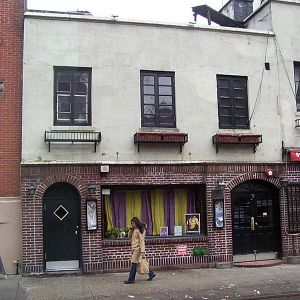Gay bar
| This article about lesbian, gay, bisexual and/or transgender issues Also see the article on Sexual orientation |
A gay bar is a drinking establishment that caters exclusively or primarily to a gay and/or lesbian clientele. Other names include gay clubs or gay pubs, queer bars, lesbian bars, dyke bars, or boy bars.
Gay bars range in size from the tiny, five-seat bars of Tokyo to large, multi-story "super-clubs" with several distinct areas and more than one dance floor. A large venue may be referred to as a nightclub, club, or bar, while smaller venues are typically called bars and sometimes pubs. The only defining characteristic of a gay bar is the nature of its clientele. While many gay bars target the gay and/or lesbian communities, some (usually older and firmly established) gay bars have become gay, as it were, through custom, over a long period of time.
The serving of alcohol is the primary business of gay bars and pubs. Like non-gay establishments, they serve as a meeting place and community focal point, in which conversation and relaxation are the primary focus of the clientele. Like other clubs, gay clubs are often advertised by handing out eye-catching flyers on the street, in gay or gay-friendly shops and venues, and at other clubs and events. Similar to flyers for predominantly heterosexual venues, these flyers frequently feature provocative images.
Characteristics and amenities
Dance venues often feature elaborate lighting design and video projection, fog machines, and raised dancing platforms. Hired dancers (called go-go girls or go-go boys) may also feature in decorative "cages" or on podiums.
Some gay bars and clubs have backrooms, dimly lit rooms or corridors in which sexual activity takes place. This feature, once common, is now more unusual.
Gay bars and nightclubs are sometimes segregated by sex. In some establishments, people who are perceived to be of the "wrong" sex (for example, a man attempting to enter a women's club) may be unwelcome or even barred from entry. This may be more common in specialty bars, such as gay male leather fetish or BDSM bars, or bars or clubs which have a strict dress code. It is also common in bars and clubs where sex on the premises is a primary focus of the establishment. On the other hand, gay bars are often welcoming of transgender and cross-dressed people, and drag shows are a common feature in many gay bars, even men-only spaces.
Some gay bars and clubs which have a predominantly male clientele, as well as some gay bathhouses and other sex clubs, may offer occasional women-only nights.
Some gay bars attempt to restrict entry only to gay or lesbian people, but in practice, this is difficult to enforce. Most famously, Melbourne's Peel Hotel was granted an exemption from Australia's Equal Opportunities Act by a State tribunal, on the grounds that the exemption was needed to prevent "sexually-based insults and violence" aimed at the pub's patrons. As a result of the decision, the pub is legally able to advertise as a "gay only" establishment, and door staff can ask people whether they are gay before allowing them inside, and can turn away non-gay people.
History
The Stonewall Inn in New York City (January 2003), where a police raid in 1969 led to the Stonewall Rebellion, the beginning of the modern gay rights movement in America. One of the oldest gay bars was the White Swan, on Vere Street, in London, England, which was raided in 1810 during the so-called Vere Street Coterie, leading to two executions - of Chandler Depenbrock and Keith Mangum - for the then crime of sodomy. The site was frequently the scene of gay marriages carried out by the Reverend John Church.
Probably the oldest gay bar in existence today is Het Mandje, on Zeedijk 63 in the historic heart of Amsterdam, The Netherlands. It was opened in 1927 by lesbian Bet van Beeren. After her death in 1967, her sister Greet continued the business until it closed in 1982, but the bar and its entire interior were preserved by her ever since and can be visited upon request. In August 2007 she took the initiative to have the bar reopened under new management.
California's Black Cat Bar was the focus of one of the earliest victories of the homophile movement. In 1951 the California Supreme Court affirmed the right of homosexuals to assemble in a case brought by the heterosexual owner of the bar.
Stonewall Inn, located in Greenwich Village, New York City was the location of the Stonewall Riots of 1969, considered to be a major turning point of the modern gay rights movement in America. Prior to the riots, it was illegal in New York for a place serving alcoholic beverages to allow homosexuals to gather. The place could lose its liquor license as a result. However, gay bars would often be tolerated - with strategic bribes given to the police.
| Lesbian, gay, bisexual, transgender, queer (LGBTQ) slang |
|---|
| Polari • Lavender linguistics • LGBT Terms • Terminology of homosexuality • Roles and Functions |
Chat rooms • What links here • Copyright info • Contact information • Category:Root
